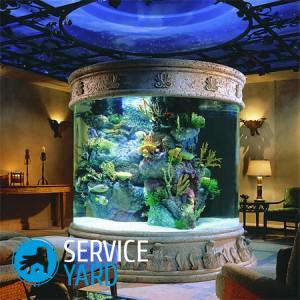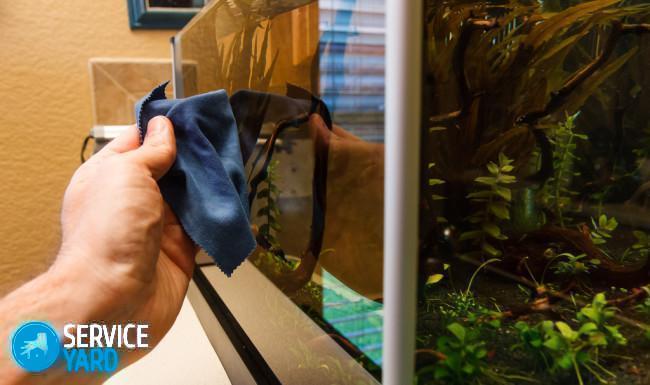How to clean glass in an aquarium?

Almost every person has a favorite pet at home. Some people have cats and dogs and some prefer fish in an aquarium. If you decide to purchase such pets, do not forget that their home requires special care and attention, like themselves. Many people care about how to clean glass in an aquarium with fish. Now in special stores offer a very wide range of cleaning products that will eliminate various types of pollution. The main thing is to ensure timely cleanliness and follow certain care rules. We will deal with everything in more detail in this article.
to contents ↑How often do I need to clean aquarium glass?
It is recommended to clean the aquarium at least twice a week. At the same time, one should take into account its size and the presence of fish and decorations. Before you start cleaning the glass in the aquarium, you need to adhere to several basic rules:
- The health of the fish - should be good.
- The appearance of the walls is better if it is only a light coating, and not a thorough overgrowing.
- Aquarium indicators - everything should be within normal limits, if something is broken, it's time to set aside time for cleaning.
to contents ↑Important! If you notice a gray-green bloom over the entire area of the fish “dwelling”, immediately proceed to clean it. Also pay attention to the level of nitrogen in the water: if it is exceeded, change the water and treat the aquarium glass with a special solution.
Aquarium Cleaning Steps
For a better cleaning result, follow the recommended instructions:
- Remove algae from the glass.
- Clean the scenery from dirt.
- Cut the plants (if any).
- Siphon the ground.
- Pour some of the water.
- Wash the filters.
- Pour in fresh water.
Important! Before cleaning the glass in the aquarium and all its other parts, do not forget to disconnect the device from the network. Only external filters can be left enabled.
We clean the walls
Even in the most well-groomed aquarium, an algal bloom forms over time, which makes the glass untidy and spoils the whole picture. Therefore, sometimes you have to remove algae. To do this, you can use:
- A stationery knife or a metal scraper is a very convenient device that easily removes dirt.
Important! It is not recommended to use for plexiglass, as it can leave scratches.
- A washcloth is the safest cleaning tool. The minus in its use is that it takes a lot of effort to reach the most inaccessible places.
- A magnetic scraper is a great option for deep installations. but it’s quite difficult for them to clean the aquarium corners and bottom. Easy to use and does not scratch the walls.
All of the above devices are very effective in cleaning aquarium glass from plaque.
Important! Do not catch the remains of algae, they can be removed by draining the water.
We wash the scenery
If you do not like the thin layer of plaque on aquarium decorations, you can remove it. You can clean the decorations both inside the aquarium and by taking them out of the water:
- Plaque is easy to remove with a washcloth or a hard-bristled brush.
- In this case, you can do without detergents.
Important! To reduce the level of plaque in the "home" of fish, you can get a species of fish that feed on the remains of algae. If you find small algae of a brownish color, urgently take measures - their presence indicates that the aquarium has an unfavorable atmosphere for pets.
We process plants
It is not enough just to clean the glass in the aquarium. The main task of the general cleaning of the fish house is the removal of damaged leaves of underwater plants and their weeding. Plants should not interfere with each other, so occasionally they need to weed.
Important! If you decide to root plants, do this very carefully so that the water does not become very muddy. Also make sure that as little vegetable juice as possible gets into the water - many fish cannot tolerate it.
Siphonym soil and drain the water
It is recommended to drain the water using a special hose:
- We place one end of the hose closer to the bottom and carefully drain first from the most contaminated sites.
- It is advisable to pour the liquid into a light container so that it is easier to notice a small fish that has fallen into the tube.
- If you are the owner of a large aquarium fish, then you can drain the water right into the sewer, as it physically cannot get into the hose.
- Almost one half of the liquid can be drained at a time.
Important! The volume of water drained for 1 time depends on the following factors:
- Filter health.
- The number of fish.
- Animal requirements (cleanliness).
- Living plants and phytofilter.
Helpful hints:
- In order to understand how much water needs to be changed, nitrate tests should be purchased. In aquarium water, the nitrate level should be 30 ml / l. This level can be created if you regularly add clean water.
- During the harvesting process, you can make a siphon of soil. With its help, all organic pollution is eliminated. It is worth considering that such a procedure should be carried out no more than once a week, depending on the number of fish and living plants.
Important! Never change all water. This is equivalent to restarting the aquarium. It is not recommended to put fish in their “housing” immediately after harvesting. The installation should work for a while empty.
Wash the filters and pour clean water
When cleaning the filters, it is very important not to damage the small microorganisms that live in their tubes. To do this, follow these tips:
- Rinse the filter very carefully, without pressing on it.
- Usually use clean water or drained from the aquarium.
- Filter contamination is determined by the power of the water jet.
- Filters with sponges and a porous surface should be washed once or twice a week, depending on the intensity of contamination.
- Phytofiltration devices are washed much less often - once a month.
- Filter accessories can be cleaned with a cotton swab.
- After cleaning the filtration system, pour clean water.
to contents ↑Important! Do not forget that the liquid must not be poured directly onto the ground. It is advisable to put a plate on the aquarium bottom. Then turn on the filters and check the health of the fish.
Glass Cleaners
You can clean the walls of the aquarium without draining the water using special chemicals. Typically, such tools are used to clean the outside of the glass. Consider the most commonly used options:
- Aquarium Pharmaceuticals Safe and Easy Spray is a chemical suitable for cleaning aquarium glasses. Apply a small amount to the walls and let stand. Then rinse with clean water.
- Acetic acid - dilute with water in a ratio of 1: 1. Pour the solution into a spray bottle and spray the glass. After - wipe them with a damp sponge.
- Tetratec wipes - ten wet wipes per pack. Such napkins are very convenient to use. Aquarium glasses should be carefully treated with one or two napkins. They perfectly remove various types of contaminants.
Stock footage
Thus, using cleaning products and taking into account the basic rules for care, you can ensure the cleanliness of the aquarium and the well-being of your favorite fish.
- How to choose a vacuum cleaner taking into account the characteristics of the house and coatings?
- What to look for when choosing a water delivery
- How to quickly create comfort at home - tips for housewives
- How to choose the perfect TV - useful tips
- What to look for when choosing blinds
- What should be running shoes?
- What useful things can you buy in a hardware store
- Iphone 11 pro max review
- Than iPhone is better than Android smartphones




